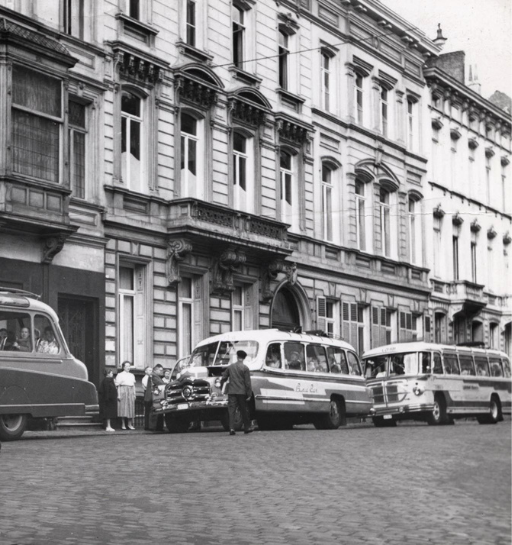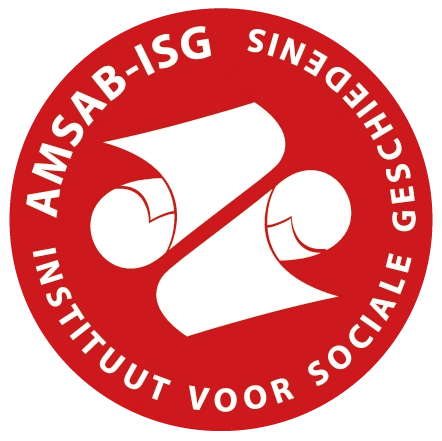Door Paule Verbruggen - historica en directeur van Amsab-ISG
Een lange voorgeschiedenis: het Nationaal Instituut voor Sociale Geschiedenis
Amsab-ISG heeft een geschiedenis, maar ook een voorgeschiedenis. Al in 1937 richtte de socialistische verzekeringsmaatschappij La Prévoyance Sociale in Brussel namelijk een Nationaal Instituut voor Sociale Geschiedenis op, naar het voorbeeld van het Internationaal Instituut voor Sociale Geschiedenis in Amsterdam.
Het NISG moest een onafhankelijk wetenschappelijk archief, een bibliotheek en een onderzoekscentrum voor sociale geschiedenis worden, zonder enige politieke binding. Een uniek initiatief in een context waarin de geschiedschrijving van sociale bewegingen (zoals politieke partijen) nog vooral een legitimerende functie had en sterk verzuild was. Het mocht ook niet zijn, want al in oktober 1940 moest het instituut gedwongen de deuren sluiten en roofde de Duitse bezetter de verworven collecties. Die werden pas in de jaren 1990 teruggevonden in het Bijzonder Staatsarchief in Moskou door Wouter Steenhaut, de eerste directeur van Amsab-ISG, en archivaris Michel Vermote.
Van partijarchief tot onafhankelijk instituut
Na de oorlog was er in de socialistische beweging nauwelijks interesse voor het eigen archief of voor actieve archiefprospectie. Die bekommernis groeide wel in de academische wereld. Bij zijn onderzoek over de vijfenzeventigjarige geschiedenis van de Belgische Socialistische Partij, gepubliceerd in 1960, realiseerde de Gentse professor Jan Dhondt zich dat er nauwelijks bronnen voorhanden waren. Hij riep iedereen die documenten had met betrekking tot die geschiedenis, op om die aan een bibliotheek te schenken. Ook zijn studenten zette hij aan om op zoek te gaan naar interessante bronnen.
Intussen was er in de jaren 1950 wel al een Museum en Archief van de Gentse Socialistische Beweging opgericht. Daarvoor hadden de bibliothecaris van de Vrijzinnige Werkmansbibliotheek Leren Vereert en de federaal secretaris van de Gentse socialistische partij de handen in elkaar geslagen. Ze brachten talrijke archieven en bibliothecair en iconografisch materiaal samen in het Feestlokaal Vooruit, maar slaagden er niet in een structurele werking uit te bouwen.
Een volgende stap werd gezet door Herman Balthazar, een doctoraatsstudent van Jan Dhondt. Bij de voorbereiding van de honderdste verjaardag van de socialistische Eerste Internationale in 1964 vond hij het documentatiebestand van het voormalige Museum en Archief terug en richtte hij met de toenmalige federaal secretaris van de Gentse partij, Gilbert Temmerman, een Gents partijarchief op. Dat kreeg twee kleine ruimtes in het Feestlokaal Vooruit en rekende vooral op vrijwilligers. In de loop van de volgende jaren breidde dat archief zich verder uit, niet alleen geografisch, maar ook thematisch: er kwamen steeds meer archieven binnen van de vakbond, de mutualiteit en de coöperaties.
Intussen had Balthazar ook de fakkel als hoogleraar overgenomen van de in 1972 – plots en te vroeg – overleden Jan Dhondt en zette hij het kritisch-wetenschappelijke onderzoek over de socialistische arbeidersbeweging voort. In 1974 werd Wouter Steenhaut zijn assistent. Zijn inzet in die beginjaren van het archief was van onschatbare waarde. Het bleef echter een grote uitdaging om voldoende financiële middelen te vinden voor de verdere professionalisering, met genoeg personeel en een adequatere infrastructuur; de dotaties van de Gentse socialistische partij waren daarvoor ontoereikend.
Professionalisering en erkenning
In de jaren 1970 was er niet alleen aan de Gentse universiteit, maar ook aan de KU Leuven een groeiende aandacht voor een meer wetenschappelijke en onafhankelijke benadering van de sociale geschiedenis, en daarmee samenhangend ook het besef dat er nood was aan een structureel archiefbeleid voor organisaties van het middenveld. Zo werd in 1976 in de schoot van de KU Leuven KADOC opgericht, oorspronkelijk als Katholiek Documentatie- en Onderzoekscentrum en met een initiële focus op het erfgoed van het katholieke organisatiewezen.
Belangrijk om weten is dat de toenmalige archiefwetgeving niet tegemoetkwam aan die nieuwe evoluties in het onderzoek: de archiefwet van 1955 bepaalde dat de rijksarchieven alleen archieven van rijksinstellingen of openbare besturen moesten bewaren. Weinig privé-instellingen en -personen waren dan ook bereid om hun archief daar te deponeren.
Omdat het Gentse socialistische partijarchief en KADOC eenzelfde nood aan structurele financiële ondersteuning hadden, staken ze de hoofden bij elkaar om subsidies aan te vragen bij de nieuwe Vlaamse overheid. Bij de eerste staatshervorming van 1980 werd België namelijk opgedeeld in drie cultuurgemeenschappen (een Nederlandse, een Franse en een Duitse) en werden onderwijs, cultuur en wetenschappelijk onderzoek geregionaliseerde bevoegdheden. Om binnen die nieuwe structuur aanspraak te kunnen maken op ondersteuning, moest het Gentse partijarchief zich echter omvormen tot een vzw. Uiteindelijk werd op 23 mei 1980 het archief van de socialistische beweging in eigendom overgedragen aan de vzw AMSAB of Archief en Museum van de Socialistische Arbeidersbeweging, met als directeur Wouter Steenhaut.
De eerste en heel belangrijke financiële stimulans kwam echter van de provincie Oost-Vlaanderen. Die stelde naar aanleiding van de honderdvijftigste verjaardag van België in 1980 het concept van een Museum van de Vlaamse Sociale Strijd voor. Samen met het in 1978 opgerichte Daensmuseum en het Archief van de Vlaamse Sociale Strijd (het latere Archief voor nationale bewegingen of ADVN), en met de structurele financiële steun van de provincie, werd het initiatief uitgewerkt tot een ‘virtueel’ museum. Daarin konden de privaatrechtelijke archief- en documentatiecentra – in 1982 kwam ook het Liberaal Archief (het huidige Liberas) erbij – beurtelings eigen onderzoeksprojecten met een publieksluik uitwerken. De vele tentoonstellingen en publicaties die eruit voortvloeiden, hebben sterk bijgedragen tot de bredere bekendheid van het rijke erfgoed van het maatschappelijke middenveld.
Echte bestaanszekerheid voor KADOC, AMSAB, ADVN en Liberaal Archief kwam er echter pas met de decretale erkenning en dus met de permanente financiering door de Vlaamse Regering in 1985.
© Amsab-ISG
Een bredere blik
Nieuwe sociale bewegingen
Vanaf eind jaren 1980 begon AMSAB geleidelijk archieven te ontvangen van wat toen nog ‘nieuwe’ sociale bewegingen werden genoemd, zoals de vredesbeweging, de vrouwenbeweging, organisaties die zich inzetten voor mondiale rechtvaardigheid en eerlijke handel zoals 11.11.11 en Oxfam Wereldwinkels, en de lgbtqia+-gemeenschap (destijds nog aangeduid als holebibeweging). Deze verbreding van het collectieprofiel kwam tot stand door een wisselwerking tussen actieve prospectie en archiefvormers die op zoek waren naar een erfgoedinstelling met een missie die aansloot bij hun maatschappelijke waarden en die garanties bood op een veilige en duurzame bewaring van hun archief.
Brood & Rozen
Inspelend op die verbreding nam AMSAB-onderzoeker Guy Van Schoenbeek in 1996 het initiatief om AMSAB-Tijdingen, het berichtenblad van onze instelling, om te vormen tot een heus wetenschappelijk tijdschrift met de prachtige titel Brood & Rozen. Hiervoor liet hij zich inspireren door de slogan We want bread and roses too die textielarbeidsters meedroegen tijdens de beroemd geworden staking in Lawrence in de VS in 1912. In 2026 vieren we de dertigste verjaardag van het tijdschrift.
Die gestage uitbreiding van de collectie wakkerde ook de discussie aan over de naam AMSAB. Uiteindelijk werd eind 1999 besloten om het letterwoord Amsab (met kleine letters) te behouden en te combineren met de titel Instituut voor Sociale Geschiedenis. Daarmee werd uitdrukkelijk verwezen naar de onafhankelijke en wetenschappelijke koers van het vooroorlogse Nationaal Instituut voor Sociale Geschiedenis.
Milieu & migratie
Intussen diende zich alweer een nieuw thema aan: de milieubeweging. Zo ontvingen we in 1996 eerder toevallig het eerste ‘groene’ archief, namelijk dat van Greenpeace Belgium. De échte katalysator was echter de samenwerking met de Bond Beter Leefmilieu (BBL) in 2002, waarna de archieven van allerlei actiegroepen rond milieu en natuur toestroomden. In de beleidsperiode 2024-2028 is de milieubeweging zelfs het focusthema van onze hele werking.
Rond het jaar 2000 kwam het thema migratie in beeld. Als nauw betrokken medewerker op dat domein onderscheidt Piet Creve twee factoren die belangrijk waren voor die evolutie. Ten eerste de publicatie van een boek over Pierre De Geyter, de componist van het lied 'De Internationale', en een van de honderdduizenden Belgen die in de negentiende eeuw naar Frankrijk trokken op zoek naar werk. Vandaar uit rees in Amsab-ISG de vraag naar het archief van de recentere arbeidsmigratie naar België. Een tweede factor was het stijgende aantal opzoekingen in de leeszaal. Door de voortschrijdende diversifiëring van de samenleving kreeg het migratiethema namelijk steeds meer aandacht van historici en sociale wetenschappers en werd de vraag naar archieven groter. Het onderwerp kreeg gaandeweg een steeds bredere invulling: van de integratiesector naar zelforganisaties, van immigratie van gastarbeiders tot vluchtelingen wereldwijd. We proberen om systematisch samen te werken met andere erfgoedspelers en zeker met het migrantenmiddenveld zelf.
Symbolisch in de geleidelijke ontzuiling van onze werking was de beslissing van Amnesty International, een organisatie die van politieke neutraliteit haar handelsmerk maakt, om in 2000 haar archief aan Amsab-ISG in bewaring te geven.
© Amsab-ISG
Een open huis in beweging
De recentste evoluties binnen ons collectieprofiel hebben betrekking op de uitbreiding naar andere vormen van erfgoed. En dat hangt samen met de voortschrijdende digitalisering van onze samenleving. Sinds 2020 werken we een digitale strategie uit, waarbij we ons in eerste instantie richten op websites, Facebookpagina’s, Twitter-accounts, enzovoort, van onze bestaande archiefvormers en van nieuwe organisaties en initiatieven rond actuele thema’s. Los van onze archiefvormers capteren we ook hashtags die relevant zijn voor onze missie. Onderzoek van enkele Amsab-medewerkers toonde aan dat sociale media ook een stem geven aan onder-gerepresenteerde groepen, doordat ze grotendeels bottom-up en gedecentraliseerd werken. Iedereen kan namelijk via hashtags persoonlijke ervaringen verwoorden en een plaats geven in het publieke debat. Vandaar hun pleidooi om methodes te ontwikkelen om dat online activisme in al zijn diversiteit te capteren, te verzamelen en te waarderen.
Ook in onze publiekswerking groeit de aandacht voor participatie en co-creatie met ondergerepresenteerde groepen. Dat impliceert ook een grotere tijdsinvestering en inzet op meer en andere vormen van communicatie. Maar het betekent geenszins dat we de band met onze roots verloochenen, of omgekeerd, oeverloos inhoudelijk uitbreiden. Wel integendeel, we houden ons collectieprofiel scherp in het oog, in lijn met onze missie: het geheugen zijn van sociale bewegingen en personen die zich verzetten tegen onrecht en ongelijkheid, streven naar gelijkwaardigheid, duurzaamheid en een betere levenskwaliteit.
We streven ook op andere vlakken naar een zo groot mogelijke openheid en dialoog. Onder directeur Geert Van Goethem onderging het pand van Amsab-ISG in 2017 een ingrijpende verbouwing. De leeszaal en publieksruimte werden volledig vernieuwd, met de duidelijke ambitie om ook infrastructuurmatig de deuren open te gooien en onze werking meer zichtbaar en toegankelijk te maken. De cijfers van ons publieksbereik tonen inmiddels aan dat die opdracht is geslaagd.
Tegelijkertijd bleef de instroom van erfgoed groeien, waardoor we – naast de aankoop van twee bijkomende depots – intussen ook een vierde depot moesten huren. Dat kon gelukkig met de welgekomen steun van de Stad Gent, die ons mee helpt om dit kostbare geheugen van sociale bewegingen veilig en duurzaam te bewaren.
Samen met andere erfgoedspelers in Vlaanderen hopen we door deze inspanningen bij te dragen aan een groter historisch bewustzijn en aan een samenleving waarin iedereen zich gezien, gehoord en gewaardeerd voelt. In een steeds meer gepolariseerde wereld is dat een behoorlijke uitdaging.








